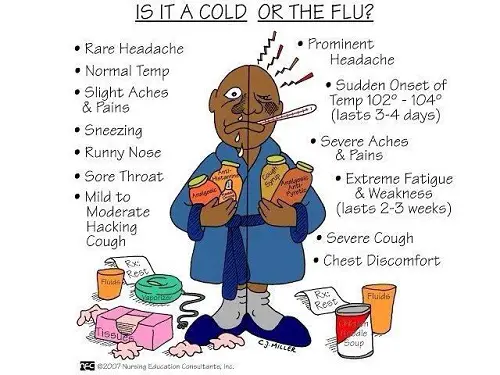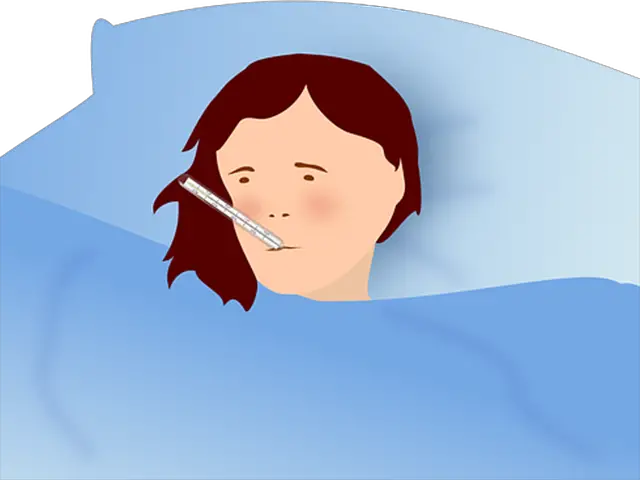Many people get a cold and flu each year. The peak flu season typically lasts from October through March, while the cold lasts from August to April.
There is a reason why the fall and winter seasons are most commonly associated with the cold and flu season. The influenza virus seems to favor a dry, chilly environment.

What Is a Cold?
An upper respiratory tract viral infection is what causes the cold. The tract includes the nose, throat, sinuses, Eustachian tubes, larynx, trachea, and bronchial tubes. Colds can spread from person to person and thus are contagious. The incubation period for colds is from one to seven days (from infection to the appearance of symptoms). The average duration of a cold is seven to ten days, but depending on the viral type, it can continue for as long as two weeks. Cold is typically thought of as a mild respiratory ailment.
To treat cold, flu, and allergy symptoms like stuffy and congested noses, sneezing runny noses, sore throats, and coughs, millions of people utilize over-the-counter (OTC) medications. Infections with viruses can also give you headaches, body aches, weariness, and occasionally fever. Other fever symptoms are itchy eyes, nose, throat, and watery eyes.
The flu symptoms can appear soon after exposure to the influenza virus. Flu symptoms are typically more severe or moderate to severe than the symptoms of colds. Additionally, while the flu is known to result in mortality from respiratory collapse occasionally, colds normally do not cause death.

What Is Flu?
A viral illness of the upper respiratory and lower respiratory systems caused by influenza viruses is known as influenza (often referred to as the flu). Unlike viruses that cause colds, influenza viruses typically cause more severe respiratory symptoms. As a result, serious flu complications are more likely to affect some people, including those 65 years and older, children, and those with specific medical disorders. Types A and B are the primary categories of influenza (flu) viruses. Every year, seasonal flu outbreaks are brought on by the influenza A and B viruses (also known as human influenza), between one and four days in the incubation period for the flu. However, the time that the flu lasts varies depending on how severe the virus is, from roughly five days to two weeks. As a result, some people who contract the flu can develop a severe disease that could be fatal.
According to most specialists, flu viruses are primarily transferred by the little droplets produced when a sick person coughs, sneezes or talks. And the droplets are then caught by people in their mouths or noses. Less commonly, someone can contract the flu by touching their nose, mouth, or eyes after contacting anything or a surface with the virus.
Similarities
Numerous symptoms of the common cold and the flu match, making it challenging or even impossible to distinguish between them. However, medical examinations can detect the flu.
Both are Contagious Illnesses
Microorganisms that enter the body and cause issues are what cause infectious disorders. A few infectious diseases are transmitted directly from one person to another and are called contagious diseases.
Contact with a sick individual who has the flu or a cold, particularly through mucus membranes, saliva, or objects that the infected person has touched (for example, towels, toothbrushes, and cups)
Contact with other items like handrails, doorknobs, and other frequently used objects that an infected individual could have touched.
By often washing your hands, avoiding ill people, and ensuring you have received all necessary immunizations, you can help protect yourself from contagious infections.
Virus Causes Both
A virus is a very small microorganism. Viruses are created from genetic material that is coated in a protein. Viruses bring on the common cold, the flu, and other well-known infectious disorders. Viruses are like hijackers. Invading living, healthy cells, they make use of those cells to expand and create additional viruses that are similar to their own. As a result, the cells may be destroyed, harmed, or altered, making you ill. Different viruses target different cells in your body, including the blood, liver, and respiratory system. Rhinovirus commonly causes colds, and the influenza virus causes flu.
Most viral infections are treated to relieve symptoms momentarily as we wait for the infection to be destroyed by the immune system. Unfortunately, you cannot treat viral infections with antibiotics. However, antiviral medications are available to treat flu and cold. In addition, vaccines can help prevent you from getting a cold or flu.
Respiratory Illnesses
Respiratory diseases can also be caused by rhinovirus and influenza viruses. In addition, both flu and cold are respiratory illnesses.
FAQS
What are the differences between a cold and the flu?
Colds and influenza (flu) are both contagious respiratory infections, although various viruses cause them. Likewise, the common cold can be brought on by various viruses, including rhinoviruses, parainfluenza, and seasonal coronaviruses, whereas influenza viruses only cause the flu.
How do I say I have a cold or flu?
You can differentiate between cold and flu by closely observing your symptoms:
A high fever is not typically associated with a cold.
Aches and pains in the muscles are symptoms of the flu.
Chest pain and congestion are two effects of the flu.
How long does a cold and flu last?
After exposure to the virus, symptoms often show up one to four days later and linger for five to seven days. Those who have had a flu vaccine may experience milder or shorter-lasting symptoms.
Is Covid-19 a cold or the flu?
COVID-19, cold, and flu are contagious respiratory diseases, yet different coronavirus (SARS-CoV-2), influenza virus, and Rhinovirus cause them, respectively.
What are the 5 symptoms of the flu?
Fever or feeling feverish/chills, weariness, cough, muscular or body pains, headaches, and sore throat are all common flu symptoms.
Does a mild Covid case feel like a cold?
Many COVID-19 survivors report that their symptoms are similar to those of a cold. However, a moderate case of COVID-19 might also resemble the flu or allergies.
Many infected people only experience milder signs of the disease, such as a scratchy throat, runny or stuffy nose, an infrequent moderate cough, lethargy, and no fever. However, some people can still spread the disease even with no symptoms. One of the more frequent early COVID-19 signs appears to be fever.












Leave a Reply